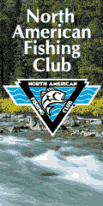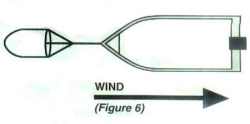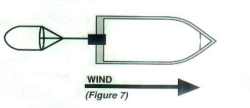
Free 90 day Risk free trial offer click
here













Promotional
Team Favorites
Lodging food and more








|
Top Walleye Pros Use Drift
Control Presentation
By Sam Anderson
Proper control of your boat will help you succeed in catching more fish
rather than having to continue to correct for wind and current. I use
Drift Control Sea Anchors and I have asked a few others to comment
along
with me on how we use these devices in a variety of fishing situations.
I have asked, Ross Grothe, Mark Brumbaugh, Mike Gofron and Ted Takasaki
to tell you the specifics and the use of Drift Control Sea Anchors.
Sam Anderson
One way that I have solved the problem with boat control is by using
a
Sea Anchor. A Sea Anchor is a cone-shaped under water wind sock, similar
to those at airports that detect changes in wind direction. Drift
Control Sea Anchors aid boat control in two ways. First of all, they
slow your drift in strong winds. Secondly, you can use them to fine-tune
subtle boat maneuvers in rough seas or heavy current.
Most anglers who fish large expansive lakes or rivers carry a Sea Anchor
with them daily. The rule is usually one Sea Anchor is adequate for
most
boats and conditions. But, if you have a large boat and the Sea Anchor
isn't doing it's job you may need a large one off the front cleat and
a
smaller one at the stern.
When fishing alone in a console boat in heavy winds, I troll headlong
into the wind with a Sea Anchor tied at the bow of the boat. By letting
out about 8 feet of rope, the bag trails next to the console. I can
yank
it out of the water with a safety cord if I need to without getting
out
of my seat and I never lose control of the boat.
That works well if you want to slow down your presentation, but control
is still very important and you have to be able to control your
presentation if you want the fish to bite. One way that I approach
control is by tying a Sea Anchor at the bow of the boat and then
backtrolling along a contour depth. By tying a Drift Control Sea Anchor
at the bow of the boat it will hold the bow down and reduces splashing
for backtrolling into the wind. This control will even allow me to
swim
a 1/16 ounce Fuzzy Grub over the rocks and keep my boat pointed in
the
direction I want to go, rather than the way the wind wants to push
me.
Although there are several advantages to casting over trolling, don't
think that casting is more effective than trolling. I still troll more
than cast. But casting is a very effective method of presenting a bait
to walleyes in some situations. Using your boat as a tool to improve
not
only casting, but also jigging and rigging in the spring can also put
you more in control. Remember, to become a versatile walleye fisherman,
it is important to be able to adapt to changing conditions.
Ross Grothe
Walleyes in the wind is not a subject that you read about everyday.
Most
fishermen probably won't go out on windy days because they can't control
their boats or they can't feel the jig on the bottom. A windy day can
and does produce walleyes and sometimes the best walleye fishing comes
when it is windy.
Wind also has an effect on light penetration. The wind creates waves,
and waves cut down on light penetration. That's why you'll find walleyes
on a shallow reef on a bright day if it's windy. Take the same reef
on a
bright day, calm day, and frequently it will be devoid of fish.
I generally start looking for walleyes on the wind-blown side of the
lake, and the wind-blown side of a structure. Walleyes will usually
be
the most active on the side of the lake or reservoir that the wind
is
blowing into because that's where light penetration is reduced. On
a
given piece of structure the same will hold true with baitfish being
disorientated because of wave action. This is a key area, because the
predators will congregate at the outside edge and feed on the baitfish.
However, keep in mind that a good walleye structure that is not
windblown will still be better that a poor walleye structure that is
not
windblown. Walleyes are opportunistic fish and will go where the meal
is
the easiest to catch.
There are some wind directions that I prefer over others. It seems
that
north, northeast, and northwest winds can have detrimental effect on
fishing success. They usually indicate a coming change in weather.
Winds
coming from the northwest are a good indication that a cold front is
pushing across your favorite fishing hole. In the spring and fall this
usually turns the fish off and the bite is very slow.
Winds from the south or southwest are frequently good fishing winds.
They bring warmer air, which can be a good deal in the spring and fall.
They are commonly known indicators of stable weather conditions.
As I mentioned before boat control is always a problem in the wind.
With
a little practice and a drift sock you can control your boat even on
the
toughest structure.
Backtrolling downwind is also possible and necessary on some days,
when
you don't want your boat to rock so much in waves. This reduces the
jigging action of your bait, and at times, walleyes are turned off
by
too much vertical action. The Tournament Series Drift Control Sea Anchor
acts like a big tail. You get excellent boat control by going with
the
wind and easing the throttle in and out of gear.
When fishing a windy, unprotected point, one option is to deploy two
Sea
Anchors and drift the tip. But a better option might be to use only
one
bag off the bow and backtroll into the wind to cover both the tip and
each inside turn. Be sure to tie the bag on the bow eye, not on a side
cleat.
The position where you tie off is critical to control. You should
experiment with your positioning of the Sea Anchor, and how it affects
your boat, before launching out into gale force winds. Along with that,
if you fish with a partner, you both should get used to fishing in
and
around a bag. If your partner doesn't reel in the bag when you have
a
tournament winning walleye on, it can be disastrous. Practice with
the
bag, as well as with the positioning of the tie off rope on your boat.
Consider wind direction, but don't stay home just because the wind
is
blowing from the north. The wind is a tool you should use just like
your
rod, boat or you depthfinder. In conjunction with all these tools the
wind can be useful, tool so you can experience more success.
Mark Brumbaugh
Trolling is used in covering certain structures and precise trolling
means catching fish. One way that I have solved the problem with boat
control is by using a Drift Control Sea Anchor.
The rule is usually that one Drift Control Sea Anchor is adequate for
most boats and conditions. Sometimes on Lake Erie when the wind is
really stiff I will attach two Drift Control Sea Anchors, one to each
cleat off the bow section both starboard and port. This will increase
my
control and allow me to run my engine at higher rpm's to combat the
waves.
Walleye fisherman on Erie aren't the only ones using this method. Bass
fishing has virtually exploded over the last few years. In the early
season it is not uncommon to find smallmouth bass in good numbers along
the rock, and shale reefs of the islands that dot Lake Erie. Boat
control is as essential when fishing for bass as it is for walleyes.
As
many anglers know, fish are usually most active near the windblown
shore, but probably presenting a bait to them can prove a trial.
Anchoring limits you to a single spot when the fish may be someplace
else or spread along the breakline, and short wind drifts have you
motoring, casting and reeling most of the time. Bass anglers therefore,
want to slow down their presentation and not be blown off breaklines.
Here again the Drift Control Sea Anchor is used.
By tying off two Drift Control Sea Anchors to the windward side of
the
boat the boat drifts perpendicular to the contour or breakline.
Occasionally the bow mount trolling motor will correct the drift or
in
some circumstances the kicker motor will have to be nudged into gear
to
compensate for gusty winds.
Mike Gofron
Contour trolling is something that I really enjoy. Contour trolling
will
allow you to present your bait right in front of the walleyes nose.
In
cold front conditions this is essential. What you're trying to do is
stay on a particular depth, or contour, where it looks like the walleyes
are holding.
To really slow down and follow the contours I use the Drift Control
Sea
Anchor tied off the bow or starboard side of the boat. This acts like
a
brake and if I have to keep the rpm's up a little on my kicker or big
motor it still gives me control to make an inside curve or to allow
the
lure to track evenly behind the boat on the contour.
 |
Makes backtrolling more precise. tie the sock to the bow to prevent
swaying. You will enhance boat control and fish your pattern not
the winds. If your motor fails in high winds tie the sock to the
bow using a long tow rope and increase your safety by keeping the bow headed
into the wind |
If I want to jig a productive area for walleyes the Drift Control Sea
Anchor comes in handy here also. It gives me control over the stern
of
my boat so I can fish a given contour perpendicularly. By attaching
the
Drift Control to the stern cleat adjacent to the current it gives me
a
brake that slows down the drift of the back end of my boat and I can
correct the angle with the bow mount trolling motor. I can also attach
another one to the same side of boat in the bow giving me more drag
and
a slower presentation when I vertically jig this contour.
Ted Takasaki
By fishing the edges of weeds, drop-offs and structure like rocks,
you
will increase your chances of finding a funnel point where fish
concentrate. These spots vary but are based on factors like: water
temperature, availability of baitfish, oxygen, light level, structure
and schooling tendencies. Success rests with proper presentation. Once
you have located the edge and fish, the next step is to entice them
to
bite. Your bait presentation will depend upon the specific edge that
you
have selected. If the walleyes are directly below and concentrated
on a
physical edge you can backtroll a livebait rig, jig, or a bottom bouncer
rig, keeping the bait among the fish you see on the depthfinder. If
you
find the fish strung out along the edge, keep the bait moving and they
will bite. If they're clumped up in one spot, hover over them and
vertically jig them.
As I mentioned previously the success of rigging is determined on your
presentation. Boat control becomes part of your presentation when you
are rigging especially in windy conditions. If the edges of structure
is
where I want to fish then a Drift Control Sea Anchor helps me stay
on
the edges of this structure. I operate my Ranger 620 from the bow with
my Minnkota Maxxum bow-mount motor. If I am following an inside turn,
or
sitting on top of a break line I can maneuver my boat by using the
drag
that I receive from the Drift Control Sea Anchor. The Drift Control
will
allow me to make subtle changes and I will not over steer my position.
To keep in contact with the specific structure I will deploy the Sea
Anchor off the stern of my Ranger boat. It gives the stern that added
control in windy and wavy conditions. Usually, I will tie the Drift
Control Sea Anchor off short so it will not interfere with fishing
lines
or the netting of the fish, but still give me the added control of
staying on structure.
 |
Use with you bow mounted electric trolling motor by tying to the stern
of the boat. This adds more precise boat control and allows you to
follow the contour of the shoreline or hold on structure |
If you are a backtroller and you want the same type of control rigging,
then you will want to tie the Drift Control Sea Anchor off the bow
of
the boat. It will prevent the bow from swinging in the wind and keep
you
on the specific structure. Try this method when you are using spinners
along a breakline and you will see that you are fishing more than steering.
I prefer the Drift Control Sea Anchor over all the other drift socks
on
the market today, because of the ease of deployment and the compact
method of storage. Use this in conjunction with the rigging methods
described before and you will have a winning combination. Hope to see
you soon on the water!
As you can plainly see these top walleye pros use the Drift Control
Sea
Anchor for their presentations. I think if you try these techniques
you
will see a remarkable difference in your catch ratio. I would also
like
to hear from you concerning these applications or if you want to drop
me
a line and tell me where you are catching the big one. I can be reached
on the web at www.samanderson.com.

Fish
Clix Banner Exchange
Walleyes Inc. website is maintained
by Randy
Tyler Fishing the In-Fisherman Professional Walleye Circuit, Masters
Walleye Circuit and the Team Walleye Circuit. All rights reserved.Copyright
1999/2002
Please visit these site sponsors
Daiichi/Tru-Turn Hooks,
Lindy
Little Joe,
R-A.M Mounting Systems,
Ranger
boats, Mercury Outboards,
Bedford
Sales , Church Tackle, Panther
Marine Products,
Webfoots body
sock, Bait Rigs Tackle ,Dual
Pro Charging Systems, Daiwa Rods and
Reels, Driftcontrol Wind socks,
Trojan
Batteries
|




